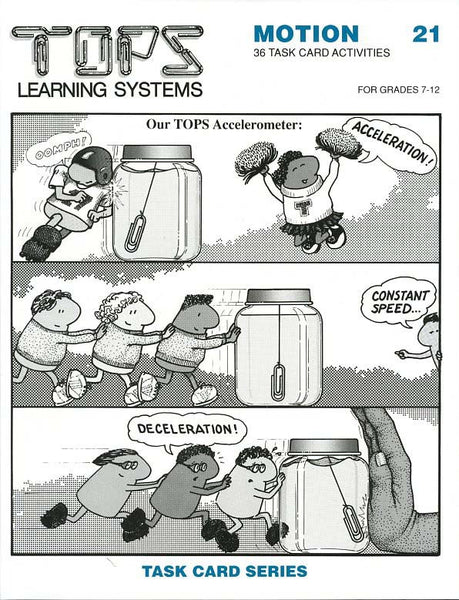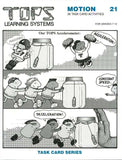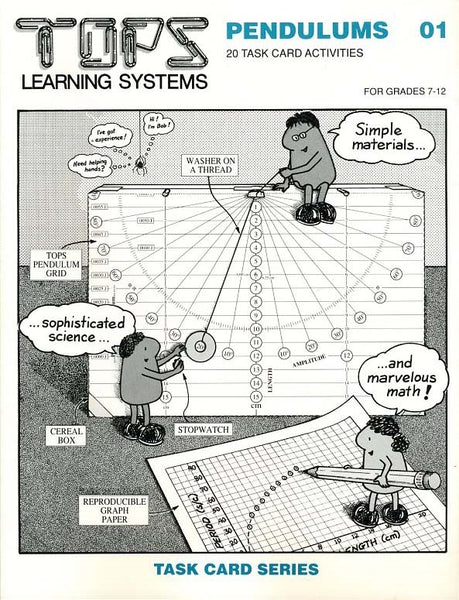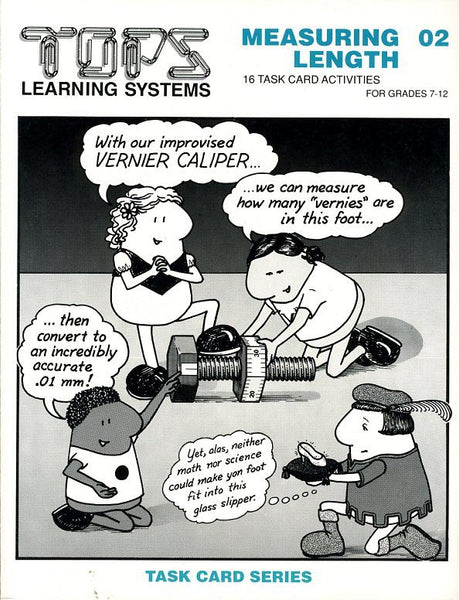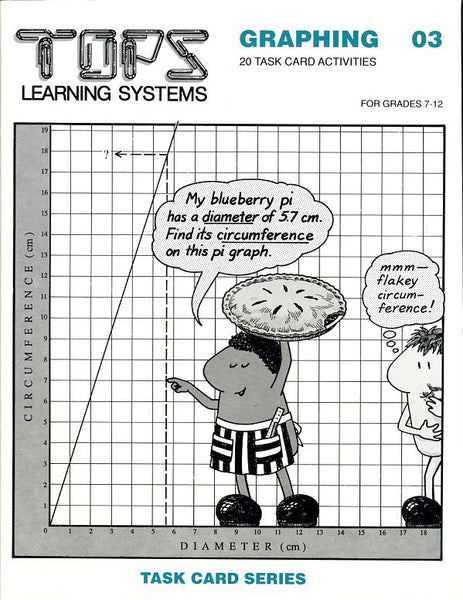#21 Motion (grades 7-12)
Regular price $22.95
Soft-bound, 88 page book, 36 reproducible task cards, full teaching notes.
Observe, analyze and graph motion: from ambulation, to acceleration, to colliding marbles. Study objects in orbit and in free-fall. Make jet straws, catapults, and more. Mass, inertia, balanced and unbalanced forces, acceleration, action and reaction all make sense. Thank Newton for all this fun!
More Information – click any of the tabs below to learn more about this title
Click here for a complete list of materials and convenient shopping.
meter sticks, string, rubber bands, masking tape, paper cups, scissors, marbles, pennies, notebook paper, buttons, adding-machine tape, felt-tipped pens, thread wall clock with second hand, calculators, index cards, dishwashing liquid, food coloring, jar lids or crucibles, Ping-Pong balls, clay, baby food jars, narrow-mouth bottles, aluminum foil, paper clips, cardboard box, hole punch, spring scales, milk jugs, flat washers, protractors, file folders, straws, cotton ball (or feathers), clothespins, balloons, flexible drinking straws, straight pins, towels, stopwatches, pillows (or coats)- Lesson 1: To experience how the total mass of a resting body affects its tendency to remain at rest.
- Lesson 2: To experience how the total mass of a resting body affects its tendency to remain in motion.
- Lesson 3: To mark the progress of an object sliding down an incline. To relate the spacing between these marks to speed and uniform motion.
- Lesson 4: To graph the distance traveled by a sliding object as a function of time. To interpret the straightness and slope of the graph line as an indication of uniform motion and speed.
- Lesson 5: To participate in a timed race and compute average speed. To distinguish between average speed and constant speed.
- Lesson 6: To practice moving at a nearly-constant speed. To calculate distance traveled, knowing speed and time.
- Lesson 7: To graph distance as a function of time. To interpret the shape of each graph line.
- Lesson 8: To track elastic collisions between spheres of equal mass.
- Lesson 9: To track elastic collisions between spheres of unequal mass. To distinguish between elastic and inelastic collisions.
- Lesson 10: To experience how inertia keeps resting bodies at rest.
- Lesson 11: To recognize that the slow, steady application of force overcomes the inertia of a stationary book more readily than a sudden impulse does.
- Lesson 12: To apply the concept of inertia to learning a trick. To have fun.
- Lesson 13: To examine the distribution of balanced force in a line. To find 4 rubber bands of nearly equal length for later vector analysis.
- Lesson 14: To calibrate the stretch in a rubber band against a laboratory spring scale. To observe that this stretch is roughly linear.
- Lesson 15: To compare static friction with moving friction. To observe how static friction balances an applied force in an equal and opposite direction.
- Lesson 16: To study angles and magnitudes of opposing force vectors.
- Lesson 17: To build a simple acceleration indicator and observe how it responds to changes in speed and direction.
- Lesson 18: To understand acceleration as a change in speed or direction.
- Lesson 19: To describe speed and acceleration in numbers and units. To correlate motion with time vs. distance graph lines.
- Lesson 20: To track a marble as it is accelerated by gravity on an inclined plane. To understand why the marble follows a parabolic curve.
- Lesson 21: To develop a model that illustrates the interplay of inertia and gravity in orbiting satellites.
- Lesson 22: To understand Newton's second law of motion -- that acceleration increases in direct proportion to force and inverse proportion to mass.
- Lesson 23: To calculate the acceleration of gravity on 3 different masses. To observe that the result is always the same, roughly 10 m/sec^2 on Earth.
- Lesson 24: To understand why lighter objects fall through air more slowly than heavier objects.
- Lesson 25: To interpret an action-reaction event in terms of Newton's third law.
- Lesson 26: To build a rotating jet balloon. To understand its motion in terms of Newton's third law.
- Lesson 27: To construct a rubber band catapult for use in a study of force and mass.
- Lesson 28: To graph how acceleration is directly proportional to force and inversely proportional to mass.
- Lesson 29: To listen to paper clips on a string as they fall to the floor. To relate the frequency of these taps to the acceleration of gravity.
- Lesson 30: To graph the distance through which paper clips free-fall as a function of time. To calculate speed and acceleration.
- Lesson 31: To graph how free-falling paper clips accelerate as a function of time. To recognize that the acceleration of gravity is constant.
- Lesson 32: To compare acceleration down an incline with free-fall.
- Lesson 33: To clock the speed of a marble through units of distance that increase as perfect squares. To observe that these distances are proportional to time squared.
- Lesson 34: To graph the distance that a marble rolls down an incline as a function of time squared.
- Lesson 35: To recognize that gravity accelerates all objects, regardless of weight or mass, by an equal amount.
- Lesson 36: To measure reaction time by catching a dropping meter stick.
We encourage improvisation - it's one of the main goals of our hands-on approach! You and your students might invent a simpler, sturdier or more accurate system; might ask a better question; might design a better extension. Hooray for ingenuity! When this occurs, we'd love to hear about it and share it with other educators.
National Science Education Standards (NRC 1996)
Teachers of science...
A: ...plan an inquiry-based science program. (p. 30)
B: ...guide and facilitate learning. (p. 32)
C: ...engage in ongoing assessment of their teaching and of student learning. (p. 37)
D: ...design and manage learning environments that provide students with the time, space, and resources needed for learning science. (p. 43)
• Represent a central event or phenomenon in the natural world.
• Represent a central scientific idea and organizing principle.
• Have rich explanatory power.
• Guide fruitful investigations.
• Apply to situations and contexts common to everyday experiences.
• Can be linked to meaningful learning experiences.
• Are developmentally appropriate for students at the grade level specified.
Core Concepts/Processes:In the absence of unbalanced forces objects at rest tend to stay at rest, and objects in motion tend to stay in motion. • Objects have uniform acceleration in a gravitational field regardless of mass.
Core Inquiries: Investigate constant speed, acceleration and deceleration with time-vs.-distance graph lines.
Core Content: Mass • Inertia • Balanced and unbalanced forces • Uniform motion • Acceleration • Collisions • Friction • Air resistance • Free fall • Action and reaction • F = ma<
Core Content: Build jet straws and catapults.
Core Content: Sir Issac Newton (1643-1727), English mathematician and physicist, discovered laws of force and motion that profoundly affect the way we see and understand our world to this day.
TEACHING Standards
These 36 Task Cards promote excellence in science teaching by these NSES criteria:Teachers of science...
A: ...plan an inquiry-based science program. (p. 30)
B: ...guide and facilitate learning. (p. 32)
C: ...engage in ongoing assessment of their teaching and of student learning. (p. 37)
D: ...design and manage learning environments that provide students with the time, space, and resources needed for learning science. (p. 43)
CONTENT Standards
These 36 Task Cards contain fundamental content as defined by these NSES guidelines (p. 109).• Represent a central event or phenomenon in the natural world.
• Represent a central scientific idea and organizing principle.
• Have rich explanatory power.
• Guide fruitful investigations.
• Apply to situations and contexts common to everyday experiences.
• Can be linked to meaningful learning experiences.
• Are developmentally appropriate for students at the grade level specified.
Unifying Concepts and Processes
NSES Framework: Systems, order, and organization • Evidence, models and explanation • Constancy, change, and measurementCore Concepts/Processes:In the absence of unbalanced forces objects at rest tend to stay at rest, and objects in motion tend to stay in motion. • Objects have uniform acceleration in a gravitational field regardless of mass.
Science as Inquiry (content standard A)
NSES Framework: Identify questions that can be answered through scientific investigations. • Design and conduct a scientific investigation. • Use appropriate tools and techniques to gather, analyze, and interpret data. • Develop descriptions, explanations, predictions, and models using evidence. • Think critically and logically to make the relationships between evidence and explanations. • Recognize and analyze alternative explanations and predictions. • Communicate scientific procedures and explanations.Core Inquiries: Investigate constant speed, acceleration and deceleration with time-vs.-distance graph lines.
Physical Science (content standard B)
NSES Framework: Properties and changes of properties in matter • Motions and forcesCore Content: Mass • Inertia • Balanced and unbalanced forces • Uniform motion • Acceleration • Collisions • Friction • Air resistance • Free fall • Action and reaction • F = ma<
Science and Technology (content standard E)
NSES Framework: Abilities of technological design • Understanding about science and technologyCore Content: Build jet straws and catapults.
History and Nature of Science (content standard G)
NSES Framework: Science as a human endeavor • Nature of science • History of scienceCore Content: Sir Issac Newton (1643-1727), English mathematician and physicist, discovered laws of force and motion that profoundly affect the way we see and understand our world to this day.

